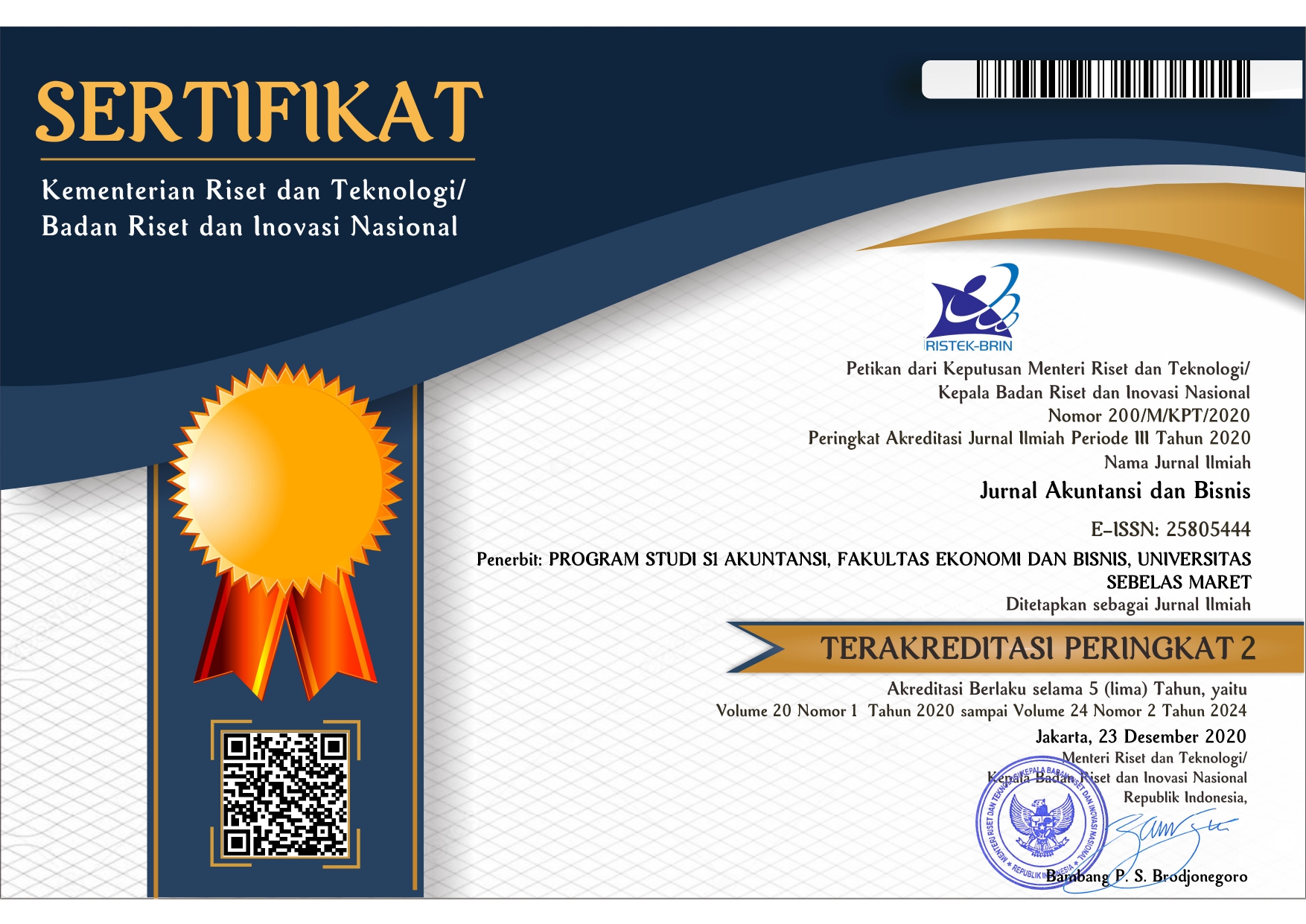Accounting for Startup: As scary as Freddy
##article.abstract##
Indonesia has enormous numbers of startup companies which grow rapidly in the past four years. However, many startups fail in the first year due to their lack of business sustainability. The problem for most startups is measurement. In order to measure its growth and efficiency, startup companies need accounting. This study aims to explore and gain an in-depth understanding from the view of startup companies on accounting. With a qualitative approach, this study used the ZMET (Zaltman Metaphor Elicitation Technique) method to dig information from seven startup companies as research participants. Using ZMET’s projective techniques through image metaphors, the study has identified thirteen important constructs which describe a mental model of startup companies toward accounting. Connections among constructs are described in the consensus map, which explains three main themes of this study’s findings: mental block of accounting, accounting as a tool, and ultimate startup goal. This study has theoretical contributions, practical contributions, and methodological contributions.
Indonesia memiliki sejumlah besar perusahaan startup yang tumbuh pesat dalam empat tahun terakhir. Namun, banyak startup gagal pada tahun pertama karena kurangnya keberlanjutan bisnis. Masalah yang banyak dihadapi oleh startup adalah pengukuran. Akuntansi diperlukan oleh startup untuk mengukur pertumbuhan dan efisiensinya. Penelitian ini bertujuan untuk mengeksplorasi dan memperoleh pemahaman mendalam dari perusahaan startup mengenai akuntansi. Studi ini menggunakan pendekatan kualitatif, metode ZMET (Zaltman Metaphor Elicitation Technique) digunakan untuk menggali informasi dari tujuh perusahaan startup yang dijadikan partisipan. Proyeksi ZMET mengidentifikasi tiga belas konstruk penting yang menggambarkan model mental perusahaan startup terhadap akuntansi. Hubungan antar konstruk digambarkan melalui consensus map yang menjelaskan tiga temuan penting yaitu mental block akuntansi, akuntansi sebagai alat dan tujuan akhir startup. Penelitian ini mempunyai kontribusi terhadap teori, praktik dan metodologi.
##article.subject##
Full Text:
PDFReferences
Coulter, R A, G Zaltman, & K S Coulter. (2001). Interpreting consumer perceptions of advertising: An application of the Zaltman Metaphor Elicitation Technique. Journal of Advertising 30 (4): 1-21.
Coulter, R. (2006), “Consumption experiences as escape: an application of the Zaltman Metaphor Elicitation Technique”, in Belk, R, (Ed.), Handbook of Qualitative Research Methods in Marketing, Edward Elgar, Cheltenham, pp. 400-418.
Croll, A & B. Yozkovitz. (2013). Lean Analytics: Use Data to Build a Better Startup Faster. CA: O Reilly Media Inc.
Danilet, Ma, & C.S. Bobalca. (2017). Using ZMET for investigating the role of social media in the employment process. Review of Economic & Business Studies 10 (1): 9-32.
De Mel, S., D. McKenzie & C. Woodruff. (2014). Business training and female enterprise start-up, growth, and dynamics: Experimental evidence from Sri Lanka. Journal of Development Economics, 2014, vol. 106, issue C, 199-210.
Groenewegen, G & F. de Langen. (2012). Critical Success Factors of the Survival of Start-ups with a Radical Innovation. Journal of Applied Economics and Business Research, 2(3): 155-171.
Hancock, C & Foster, C. (2019). Exploring the ZMET methodology in Services Marketing. Journal of Services Marketing 34 (1): 48-58.
Kasali, R. (2018). The Great Shifting. Gramedia Pustaka Utama Indonesia.
Khoo-Lattimore, C, M Thyne, & K Robertson. (2009). The ZMET method: Using projective technique to understand consumer home choice. The Marketing Review 9 (2): 139-154.
McClure. (2008). Startup Metrics for Pirates. London: Seed Camp University.
Nandram, S. S., & Boemans, M. (2001). De beste ondernemer: Condities voor ondernemerssucces. Breukelen: Universiteit Nyenrode.
Puspasari, N., Herwiyanti, E., & Pinasti, M. (2021), Barking Up the Wrong Tree: SMEs' Perception of Tax using the ZMET Method. In: Journal of Economics and Business, Vol.4, No.1, 147-156
Rauch, A. (2000). Success Factors of Small and Medium Sized Enterprises. Amsterdam: Universiteit van Amsterdam.
Ries, E. (2011). The lean startup: How today's entrepreneurs use continuous innovation to create radically successful businesses. New York: Crown Business.
San Juan-Donatila Agtarap. (2007). Fundamentals of Accounting Fundamentals of Accounting: Basic Accounting Principles Simplified for Accounting Students. USA: AuthorHouse.
Soto, E. (2015). Innovation accounting methods to assure validated learning: the case of Finnish startups. Turku University of Applied Sciences.
Zaltman, G. (1996). Metaphorically speaking: New technique uses multidisciplinary ideas to improve qualitative research. Marketing Research 8 (2): 13-20.
Zaltman, G. (1997). Rethinking market research: Putting people back in. Journal of Marketing Research 34 (4): 424-437.
Zaltman, G, & R H Coulter. (1995). Seeing the voice of the customer: Metaphor-based advertising research. Journal of Advertising Research 35 (4): 35-51.
Internet References:
https://www.startupranking.com
Drobotdean. (2019). Potrait of a confused
african man. Retrieved from https://
www.freepik.com
Bedneyimages. (2016). Whiteboard with formulas. Retrieved from https://
www.freepik.com
Gpointstudio. (2021). Man checking time on
his watch. Retrieved from https://
www.freepik.com
Jcomp. (2018). Happy man with cash dollars flying in home office, rich from
business online concept. Retrieved
from https://www.freepik.com
https://flickr.com
DOI: http://dx.doi.org/10.20961/jab.v21i1.606
Jurnal Akuntansi dan Bisnis (JAB)
ISSN 1412-0852 (print), 2580-5444 (online)
Published by Accounting Study Program, Faculty of Economics and Business, Universitas Sebelas Maret, Indonesia

JAB on http://jab.fe.uns.ac.id/index.php/jab is licensed under a Creative Commons Attribution-ShareAlike 4.0 International License










